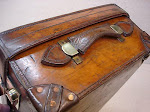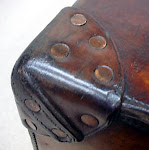Restoring colour and re-finishing old leather:
Most leather items from the 1940s will have faded and lost colour over the years. Re-dying with bright, vibrant colours is not particularly difficult; but it can be risky as you will almost certainly have no idea what products have been applied to the leather item since it was made.
Most 1940s leatherwork was originally dyed with fairly sombre colours. Shoes and handbags made with pre-war leather were sometimes available in brighter but still 'muted' colours but black and shades of brown and tan were prevalent.
To match these colours you will need to source a range of spirit based dyes. Fiebings produce excellent dye and supply it in relatively small pots which are ideal for restoration jobs. It isn't particularly cheap so spend time matching your project against the colour charts to make sure you get the right colour dye.
The best way to buy your dye may be to take your project to a specialist repair shop and ask them to show you their range of dye colours on a strip of veg-tan leather finished with a wax top coat. This will give you a good idea of the final colour match.
Before you begin to dye the project make sure it is absolutely clean and any polish or surface wax has been removed. If this is not carried out then you risk 'spotting' as wax resists dye. It is possible to buy cleaning and de-greasing products but for most purposes methylated spirit will work well enough.
Using a cotton bud, start work on an inconspicuous part of the project and ensure the leather responds well to the cleaner. If there is any sign of bubbling or flaking stop work and seek expert advice.
When your leather is clean and you have tested for adverse reactions, using a wool daub (Fiebings supply one with every bottle of dye) start to colour the project. Use long, overlapping strokes of the daub and repeat the process if your work develops streaks. You are aiming for an even colour all over.
Note: An artist's or modelmaker's airbrush can be extremely useful as it will allow dye to be applied evenly over an entire project. Make sure any areas that are not to be coloured are adequately masked using appropriate paper and masking tape.
Re-conditioning leather
Remember: sunlight fades leather very quickly and being kept in a centrally heated house will dry it out so it is important to 'feed' your leather soon after dying. Use a good quality product like Skidmore's Restoration Cream (see: www.barefootleather.co.uk) as this will help to make and keep the leather supple.
Having restored and re-dyed your project we suggest that Lexol liquid conditioner is used to maintain the leather. It is lovely stuff to use and a little goes a very long way. Apply with a soft cloth (see: www.barefootleather.co.uk)
Thursday, 11 December 2008
Subscribe to:
Post Comments (Atom)






No comments:
Post a Comment